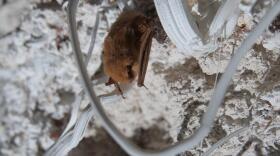-
A childhood story about the disappearance of a Costa Rican toad sent Trevor Ritland on a quest. The Flagstaff writer and documentary filmmaker tells the story in his new book, out today.
-
Over half of venomous snake bites in the U.S. occur due to improper handling or attempts to kill rattlesnakes. So, learning how to safely deal with these animals is important.
-
The Ajo Lily is the only species of its genus, an unusual phenomenon known to botanists as ‘monotypic.’ Also known as the Desert Lily, this relatively rare plant grows in one of the hottest, driest places on earth.
-
Natural disasters take a toll on mental health, particularly for children. In Flagstaff, kids have had to deal with the upheaval of the pandemic and multiple fires and floods in recent years. But nature can also be the cure. KNAU’s Melissa Sevigny reports, a pilot program in “horticultural therapy” at Killip Elementary is tapping into the surprising power of plants.
-
A new study from Northern Arizona University traces the carbon in the atmosphere over the last 100 years through a unique scientific instrument: wildflowers. Scientists examined century-old specimens of local plants to get insights into how the climate is changing. KNAU’s Melissa Sevigny spoke with lead author Mariah Carbone about how bombs detonated in the 50s and 60s left a signature behind.
-
The Grand Canyon is riddled with caves, and many of them hold secrets…. But none so strange as the Mystery of the Mummified Bats.
-
A new Netflix documentary tells the story of the letters laced with anthrax that were sent through the U.S. mail just after the 9/11 attacks in 2001. The anthrax letters ultimately killed five Americans. The film features Northern Arizona University professor Paul Keim, whose research revealed the anthrax wasn’t part of a foreign terrorist plot but sourced from an American laboratory. KNAU’s Melissa Sevigny spoke with Keim about the role of science in the high-profile case.
-
Plants and animals are beginning to shift their ranges as the climate heats up. But computer models that forecast the future may be underestimating how many species are at risk of extinction.
-
A study published in Science last week shows butterfly populations are declining by almost two percent a year in the Western U.S. The authors say that’s…
-
Sand is an important resource in the Grand Canyon. It creates campsites for river runners, protects archeological sites, and provides wildlife habitat.…

Play Live Radio
Next Up:
0:00
0:00
Available On Air Stations










